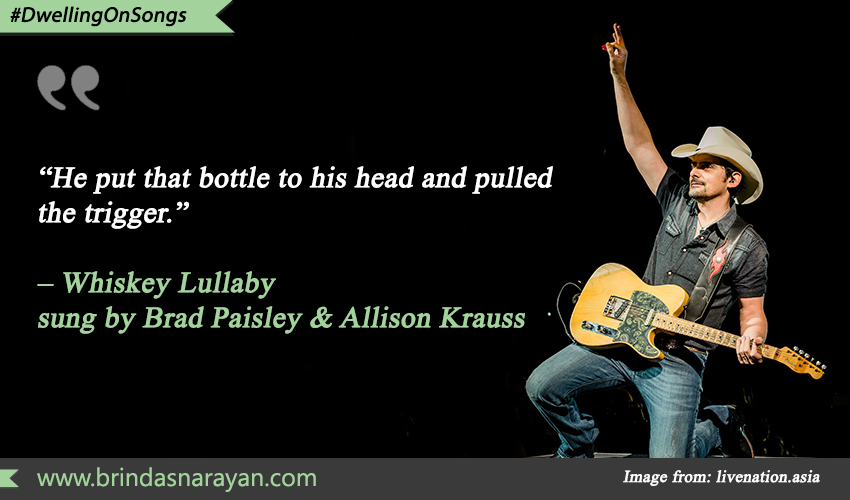
Whiskey Lullaby: Inebriation and Love Woven Into a Song
I can’t sing. I can’t carry a tune, not even of a nursery rhyme or of any other ditty. For those of us who speak quite easily, it’s rather astonishing that the brain/body circuits that produce music are aggravatingly absent. As a result, I both envy and revere those who can marry words with tunes. After all, as writers, we are acutely conscious of the limitations of language. We cannot, in a single line, convey contradictory emotions, all stranded together in a bittersweet mélange. We can’t, for instance, evoke the pangs of nostalgia, the torment and simultaneous solace, with the exactitude that singers can. Even poetry, braided with beats and rhythms, cannot enrapture stadium-sized audiences the way music can.
As the American poet Wyn Cooper writes: “Listening to poetry requires concentration, as there’s no music to listen to along with it. Whereas when I hear a song for the first time (and many times after that), I don’t pay attention to the words. It’s the music that moves me, makes me care or not care, and after that I can listen to the words.”
Since I can’t make music, I listen – sometimes flippantly, sometimes with attention. To accompany me on walks to the park, I have been exploring new singers. Not new, as in singers who have recently debuted their first song or YouTube channel; but rather singers who have been unfamiliar to me. One of my recent picks is the country musician Brad Paisley, who I understand from online research, commands a large fan following. I want to dwell in particular on one of his songs, Whiskey Lullaby, which expresses in a pithy twenty-six lines, the passions, the miscues, the heartache and remorse of a married couple, who drive each other to tragic, despairing deaths.
Romance that culminates in suicide is older than Romeo and Juliet; and the intertwining of love and tipsiness recognizable to readers, before Sarat Chandra Chattopadhyay wrote Devdas in 1917. While the theme that fuels Paisley’s song is not groundbreaking, the manner in which it’s written and sung feels like you’re experiencing all this anew.
To summarize the scenes depicted in the music video: a World War II soldier, when returning home on a bus, glimpses a photograph that stirs memories of his wife. When he gets home, he finds her in bed with another man. He rushes out, confused and agitated, while the remorseful wife beckons hopelessly at his turned back. He drinks himself into an unfeeling stupor till, one day, “He put that bottle to his head and pulled the trigger.” The wife attends his funeral and follows suit: “For years and years she tried to hide the whiskey on her breath.”
Paisley did not write the song. It was written by Bill Anderson and Jon Randall. A significant personal story preceded the writing: apparently, Randall had been recently divorced and “had lost a record deal.” Wallowing in a personal low while awaiting a songwriting contract, he took to drinking whiskey and engaging in casual sex. His manager pulled him up one day and said: “Hey man, every now and then you’ve got to put a bottle to your head and pull the trigger.”
Fortunately for him, Randall possessed the sobriety and wits to recognize how that line ingeniously wove so many elements together and could give rise to others. Including the piercing first line, also a shoo-in for a favorite: “She put him out like the burnin’ end of a midnight cigarette.”
The final version, sung by Brad Paisley and Allison Krauss, brings everything together in an arresting music video. In which, like the best short films, there is more unsaid than said. It’s set in a world filled with tangible objects: photographs, willow trees, a house, a piano, a truck, a bike, a dirt road, gravestones. Woven with the ineffable: memory, vows, kinship, marriage, betrayal, heartbreak, drunkenness, suicide, grief, afterlife.
It’s the nature perhaps, of the central emotion that’s being described. Love, which is, on the one hand, utterly hackneyed, surely overdone. And yet, mysterious enough to keep us in thrall even in exaggerated versions. In story after story, film after film, song after song.
References




